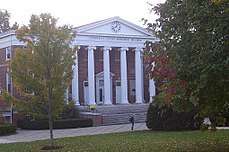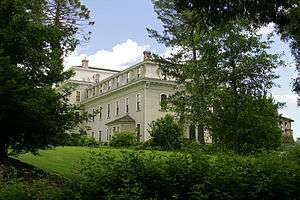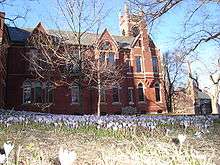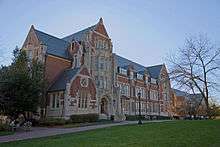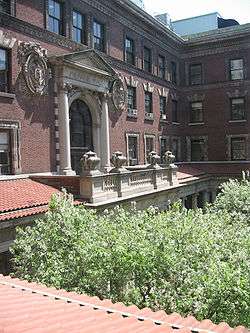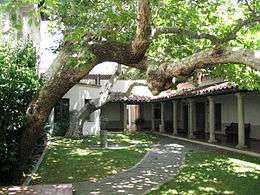Timeline of women's colleges in the United States
The following is a timeline of women's colleges in the United States. These are institutions of higher education in the United States whose student population comprises exclusively, or almost exclusively, women. They are often liberal arts colleges. There are approximately 60 active women's colleges in the U.S.
Colleges are listed by the date in which they opened their doors to students.
First and oldest
| Education in the United States |
|---|
|
|
|
Many of the schools began as either schools for girls, academies (which during the late 18th and early 19th centuries was the equivalent of secondary schools), or as a teaching seminary (which during the early 19th century were forms of secular higher education), rather than as a chartered college. During the 19th century in the United States, "Seminaries educated women for the only socially acceptable occupation: teaching. Only unmarried women could be teachers. Many early women's colleges began as female seminaries and were responsible for producing an important corps of educators."[1]
The following is a list of "oldest" and "first" schools:
- 1742: Bethlehem Female Seminary, (now Moravian College): established as a seminary for girls, it eventually became the Moravian Seminary and College for Women and later merged with nearby schools to become the coeducational school, Moravian College.
- 1772: Salem College, North Carolina: Formed as the Little Girls' School by the Moravian Single Sisters and then renamed as the Salem Female Academy, it is the oldest women's educational institution to be in continuous operation.[2][3]
- 1803: Bradford Academy - First Academy in Massachusetts to admit women. The first graduating class had 37 women and 14 men.
- 1818: Elizabeth Female Academy: first female educational institution in Mississippi; it closed in 1843
- 1821: Clinton Female Seminary in Clinton, Georgia; later merged to become Georgia Female College (now Wesleyan College in Macon) chartered in 1836; the first college charted from its inception as a full college for women.
- 1827: The Linden Wood School for Girls (now Lindenwood University): is the first institution of higher education for women west of the Mississippi River.
- 1833: Columbia Female Academy (now Stephens College): Originally established as an academy (for both high school and college-aged women), it later became a four-year college. It is the second oldest female educational establishment that is still a women's college.
- 1837: St. Mary's Hall (now Doane Academy): Originally established as a female seminary by George Washington Doane 2nd Bishop of the Episcopal Church of New Jersey. First academic school founded on church principles in the United States. Now a PK-12 Co-educational day school.
- 1837: Mount Holyoke Female Seminary (now Mount Holyoke College): It is the oldest (and first) of the Seven Sisters. It is also the oldest school which was established from inception (chartered in 1836) as an institution of higher education for women (teaching seminary) that is still a women's college.
- 1838: Judson College for Women, Marion, Alabama. It was also intended as an institute of higher learning from inception. It is still carrying on its mission "Since 1838, Judson College has been committed to preparing young women for lives of purpose through the transmission of knowledge, the refinement of intellect, the nurturing of faith, the promotion of service, and the development of character. A private, four-year, Christian college with degree programs in liberal arts and the sciences, Judson College helps each student reach her full potential by providing her with opportunities to engage her mind, practice her faith, and live her purpose."
- 1839: Georgia Female College (now Wesleyan College): It is the oldest (and the first) school which was established from inception (chartered in 1836) as a full college for women.
- 1844: Saint Mary's College (Indiana): Founded by the Sisters of the Holy Cross. The first women's college in the Great Lakes region (founded in southern Michigan, and moved to its present site in Notre Dame, Indiana in 1855).
- 1845: Limestone College in Gaffney, SC. Limestone was the third private college in SC and the first women's college, which it remained until becoming fully coeducational in the 1960's.
- 1848: Philadelphia School of Design for Women (now Moore College of Art and Design): It is the first and only art school which is a women's college.
- 1850 "Women's Medical College of Pennsylvania" (now part of "Drexel University") trained and graduated the first female physicians in the country and the first black female physicians.
- 1851: Cherokee Female Seminary: It is the first institute of higher learning exclusively for women the United States west of the Mississippi River. Along with the Cherokee Male Seminary, this was the first college created by a tribe instead of the US federal government.
- 1851: Auburndale Female Seminary (now Lasell College): A private institution founded by Edward Lasell, becomes the first "successful and persistent" junior college in the United States, and the first junior college for women. It began offering four-year bachelor's degrees in 1989 and became coeducational in 1997.
- 1851: Tennessee and Alabama Female Institute (later Mary Sharp College): It was the first women's college to grant college degrees to women that were the equivalent of those given to men; the college closed due to financial hardship in 1896.
- 1851: "College of Notre Dame" (now Notre Dame de Namur University): This was the first women's college in California and the first in the state authorized to grant the baccalaureate degree to women. The university is now coed.
- 1852: Young Ladies Seminary (now Mills College): It is the first women's college in United States west of the Rocky Mountains
- 1853: Mt. Carroll Seminary (now Shimer College): A women's seminary started by Frances Shimer, became coeducational in 1950.
- 1854: Columbia Female College (now Columbia College): Located Columbia, South Carolina. The college has survived the march of General Sherman and 3 campus fires. Georgia O'Keeffe taught for a year before she created her own artistic way. The college's day program is still all-female, but its evening program is coed.
- 1855: Davenport Female College (later Davenport College): Founded in Lenoir, North Carolina. Merged with Greensboro College in 1938.
- 1855: Elmira Female College (now Elmira College): It is the oldest college still in existence which (as a women's college) granted degrees to women that were the equivalent of those given to men; the college became coeducational in 1969.
- 1861: Vassar College: One of the Seven Sisters which was established from inception as a college for women; it became coeducational in 1969.
- 1867: Cedar Crest College: Established in 1867 in the basement of a church, it now is one of the top modern female colleges.
- 1867: Scotia Seminary (now Barber-Scotia College): It was the first historically black female institution of higher education established after the American Civil War and became a women's college in 1946. It became coeducational school in 1954 and lost its accreditation in 2004.
- 1868: Wells College: Located in Aurora, N.Y. Went coed in 2005.
- 1869: Chatham University: Located in Pittsburgh, PA. Established as Pennsylvania Female College, renamed Pennsylvania College for Women in 1890 and to Chatham College in 1955. Chatham gained University status in 2007.
- 1870: Wellesley College chartered; opened in 1875. One of the Seven Sisters which was established from inception as a college for women and remains such to this day.
- 1871: Smith College chartered; opened in 1875. One of the Seven Sisters which was established from inception as a college for women and remains such to this day.
- 1871: Ursline College was established from inception as a college for women in Cleveland, Ohio by the Sisters o Ursline. The Sisters of Ursline had come to Cleveland from France and were granted a charter by the state of Ohio. Ursline College is still an all women's institution of higher education
- 1878: Georgia Baptist Female Seminary (now the Brenau University Women’s College): Despite its name, the college was never formally associated with any church or religious group. Founded in Gainesville, Georgia, it became Brenau College in 1900 and Brenau University in 1992. The university still boasts its robust Women’s College on its historic Gainesville campus today, educating women to be, as its motto states, “as gold refined by fire.”
- 1881: Atlanta Baptist Female Seminary (now Spelman College): It was the first historically black female institution of higher education to receive its collegiate charter in 1924, making it the oldest historically black women's college.
- 1884: Industrial Institute & College, (now Mississippi University for Women): It was the first public women's college; became coeducational in 1982 as a result of the Supreme Court's Mississippi University for Women v. Hogan case, but maintained its original name.
- 1884: Vernon Seminary (Now Cottey College) was founded by Virginia Alice Cottey in Nevada, Missouri. The college was transferred ownership to the P.E.O. Sisterhood in 1927.
- 1885: Bryn Mawr College founded. One of the Seven Sisters which was established from inception as a college for women and remains such to this day. The College’s mission was to offer women rigorous intellectual training and the chance to do to original research, a European-style program that was then available only at a few elite institutions for men. The College established undergraduate and graduate programs that were widely viewed as models of academic excellence in both the humanities and the sciences, programs that elevated standards for higher education nationwide.
- 1893: the Woman's College of Frederick (now [Hood College]): The Potomac Synod purchased the building and equipment from the failing Frederick Female Seminary (in Frederick, MD) to move the women's department from Mercersburg College in Pennsylvania to a spot below the Mason-Dixon Line.
- 1895: College of Notre Dame of Maryland (now Notre Dame of Maryland University): First Catholic women's college in the United States to offer the four-year baccalaureate degree.
Timeline
Colonial–era schools

- 1742: Bethlehem Female Seminary: Founded in Germantown and later moved to Bethlehem, Pennsylvania. It received its collegiate charter in 1863 and in 1913, it became the Moravian Seminary and College for Women. In 1954, it merged with the male institution Moravian College and Theological Seminary and became the coeducational school, Moravian College[4]
- 1772: Little Girls' School (now Salem College), Winston-Salem, North Carolina: Originally established as a primary school, it later became an academy (high school) and finally a college. It is the oldest female educational establishment that is still a women's college, and the oldest female institution in the Southern United States.
1780s–1820s
- 1787: Young Ladies' Academy of Philadelphia
- 1792: Mrs. Rowson's Academy for Young Ladies, Boston, MA: Prolific writer and actress Susanna Rowson founded this progressive school for middle-class young women.[5]
- 1792: Litchfield Female Academy, Litchfield, CT: Sarah Pierce founded the school and developed its curriculum; it closed in 1833.[6]
- 1803: Bradford Academy (now Bradford College), Bradford, MA: Formed as a coeducational secondary school, it became a college-level women's institution in 1836; it became coeducational again in 1972.[7]
- 1814: Louisburg Female Academy (now Louisburg College): Founded in North Carolina; Louisburg Female College, founded in 1857. Later merged with Franklin Male Academy
- 1814: Nazareth Academy (now Spalding University): Founded near Bardstown, Kentucky; given degree-granting authority in 1829. Opened its current Louisville campus in 1920; all instruction moved to Louisville in 1971. Became coeducational in 1973.
- 1814: Troy Female Seminary, Troy, NY: It became the Emma Willard School in 1895
- 1818: Elizabeth Female Academy: First female educational institution in Mississippi; it closed in 1843
- 1821: Clinton Female Seminary: Georgia. Forerunner to Wesleyan College
- 1822: Gummere Academy, Burlington, NJ: Founded by Quaker Sammuel Gummere who then sold the school to George Washington Doane who then founded St. Mary's Hall.
- 1822: Athens Female Academy (now Athens State University), Athens, Alabama.
- 1823: Hartford Female Seminary, Hartford, CT: It closed towards the later half of the 19th century
- 1827: The Linden Wood School for Girls (now Lindenwood University), St. Charles, Missouri: became coeducational in 1969.
- 1828: Ipswich Female Seminary, Ipswich, MA: Founded by two female educators, Zilpah Grant and Mary Lyon, it was the first women's seminary in the nation to be endowed and to offer its graduates diplomas; it closed in 1876.[8]
1830s
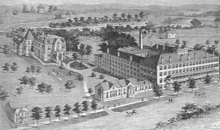
- 1831: LaGrange Female Academy (now LaGrange College): Founded in LaGrange, Georgia, it became LaGrange Female College in 1851, and coeducational in 1953
- 1833: Columbia Female Academy (now Stephens College): Originally established as an academy (high school), it later became a college. It is the second oldest female educational establishment that is still a women's college
- 1834: Green River Female Academy: founded in Todd County, Kentucky was an all-female preparatory school until 1861 when it became co-educational; the building is now restored and run as a museum by the Green River Academy Preservation Society
- 1834: Wheaton Female Seminary (now Wheaton College, Massachusetts): Founded with the help of Mary Lyon; Wheaton became a college in 1912 and coeducational in 1987
- 1835: Livingston Female Academy and State Normal College (now University of West Alabama); It became coeducational in the 1950s
- 1836: Holly Springs Female Institute, Holly Springs, MS: Destroyed by the Union Army in 1864.
- 1836: Washington Female Seminary: closed in 1948
- 1836: Wesleyan College: Chartered as the Georgia Female College on December 23, 1836, Wesleyan is the world's oldest women's college. Still a women's college
- 1837: St. Mary's Hall (now Doane Academy): Originally established as a female seminary by George Washington Doane, the 2nd Bishop of the Episcopal Church of New Jersey. First academic school for women in the United States founded on church principles.
- 1837: Mount Holyoke Female Seminary (now Mount Holyoke College): It is the oldest (and first) of the Seven Sisters
- 1837: Sharon Female College: closed in 1873.
- 1837: Female Collegiate Institute founded in Georgetown, Kentucky; moved to Millersburg in 1848 and in 1862 renamed Millersburg Female College; in 1931 incorporated into Millersburg Military Institute, now defunct
- 1838: Judson Female Institute (Judson College (Alabama)): Founded in Marion, Alabama, it became Judson College in 1903 and later Judson College
- 1839: Farmville Female Seminary Association (now Longwood University): Founded in Farmville, Virginia; it became coeducational in 1976.
1840s
- 1841: Saint Mary-of-the-Woods College: The college was founded as an academy for young women in 1841 by a French nun, Saint Mother Theodore Guerin. Saint Mary-of-the-Woods College is the nation's oldest Catholic liberal arts college for women. In 1846, Saint Mary-of-the-Woods College was granted the first charter for the higher education of women in the state of Indiana. SMWC conferred its first bachelor of arts degree in 1899. The College's campus program remains an all-female institute. However, SMWC now offers co-educational distance and graduate programs.
- 1841: Academy of the Sacred Heart (now Manhattanville College)
- 1842: Fulton Female Academy (now Synodical College): Founded in Fulton, Missouri, it closed in 1928
- 1842: Valley Union Seminary (now Hollins University): Established in Roanoke, Virginia as a coeducational school, it became a school for women in 1852, and was renamed Hollins Institute in 1855, Hollins College in 1911, and Hollins University in 1998
- 1842: Augusta Female Seminary (now Mary Baldwin College): Founded in Staunton, Virginia, it became the Mary Baldwin Seminary in 1895, and the Mary Baldwin College in 1923. While the school has had a coeducational adult degree program since 1977, and later added coeducational graduate degree programs, its undergraduate college for traditional students, the Residential College for Women, remains women-only.
- 1843: Memphis Conference Female Institute (later Lambuth University): Became coeducational in 1923. Closed in 2011; the former Lambuth campus now houses a branch campus of the University of Memphis.
- 1843: Port Gibson Female College: closed in 1908
- 1844: Saint Mary's College (Indiana): Founded by the Sisters of the Holy Cross. In the mid-1950s, it became the first college in the United States to grant advanced degrees in theology to women.[9]
- 1845: Baylor Female Department (established alongside Baylor University as the Female Department. Obtained separate charter in 1866, moved to Belton, TX 1886. Later names were Baylor Female College, Baylor College for Women, Mary Hardin-Baylor College, and now known as University of Mary Hardin-Baylor
- 1845: Limestone Springs Female High School: (now Limestone College) Founded in Gaffney, South Carolina, it began accepting a few male students in the 1920s (who did not live on campus) and became fully coeducational in the late 1960s
- 1846: Greensboro Female College: Charted in 1838 in Greensboro, North Carolina; it is now the coeducational school Greensboro College
- 1846: Illinois Conference Female Academy: It is now the coeducational school, MacMurray College
- 1847: Kentucky Female Orphan School (now Midway University): The school's day program at its main campus became fully coeducational in 2016; evening, weekend, and online classes and programs had been coeducational for many years. It planned to open a coeducational pharmacy school at a separate campus in 2011, but withdrew that school's accreditation application for unknown reasons.
- 1847: Academy of Mount Saint Vincent: (now College of Mount Saint Vincent). Founded by the Sisters of Charity of New York; moved from Manhattan to current Riverdale, Bronx site in the 1850s and began service as degree-granting, four-year liberal arts college in 1911. Became coeducational in 1974.
- 1848: Philadelphia School of Design for Women (now Moore College of Art and Design): It is the first and only art school which is a women's college
- 1848: Chowan Baptist Female Institute; it is now the coeducational school Chowan University
- 1848: Drexel University College of Medicine: It is now, after several changes including becoming co-ed, Drexel University's College of Medicine
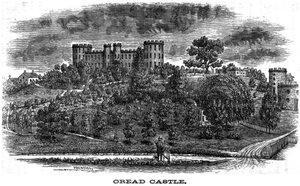
- 1849: The Oread Institute, Worcester, MA: It closed in 1881.
- 1849: Forsyth Female Collegiate Institute: It became Tift College, which is now a part of Mercer University.
1850s
- 1850 "Women's Medical College of Pennsylvania" (now part of "Drexel University") trained and graduated the first female physicians in the country and the first black female physicians.
- 1850: Carolina Female College: It was established in Anson County by an act of the North Carolina legislature. Closed in 1867 for financial reasons.[10]
- 1851: Christian College (later Columbia College): It was the first women's college west of the Mississippi River to be chartered by a state legislature.[11]
- 1851: Cherokee Female Seminary: It is the first institute of higher learning exclusively for women the United States west of the Mississippi River. Along with the Cherokee Male Seminary, this was the first college created by a tribe instead of the US federal government.
- 1851: Tennessee and Alabama Female Institute (later Mary Sharp College): It was the first women's college to grant college degrees to women that were the equivalent of those given to men; the college closed due to financial hardship in 1896.
- 1851: Yalobusha Female Institute: Later the Emma Mercer Institute and then Grenada Female College. Closed in 1936 for financial reasons.
- 1852: Young Ladies Seminary (now Mills College): It is the first women's college in United States west of the Rocky Mountains
- 1853: Beaver College: It became the coeducational school Arcadia University
- 1853: Ohio Wesleyan Female College: It merged with Ohio Wesleyan University in 1877
- 1853: Mt. Carroll Seminary Later Frances Shimer Academy (now Shimer College): became a coeducational in 1950 and later adopted the Great Books curriculum.
- 1854: Columbia College (Columbia, South Carolina)
- 1854: Andrew Female College (now Andrew College): Became coeducational in 1956
- 1854: Sayre Female Institute, Lexington, Kentucky, founded in 1854 as the Transylvania Female Institute; renamed in honor of founder David Sayre in 1855 and moved from Mill Street to present location (now Sayre School); chartered in 1856 to confer collegiate degrees; continues today as a private coeducational college preparatory school.
- 1855: Elmira Female College (now Elmira College): It is the oldest college still in existence which (as a women's college) granted degrees to women that were the equivalent of those given to men; the college became coeducational in 1969.
- 1855: Mansfield Female College: Merged into Centenary College of Louisiana in 1930.
- 1855: Western Female Seminary: Became Western College for Women and later merged with Miami University in 1974.
- 1855: Davenport Female College (later Davenport College), Lenoir, NC: Chartered by the North Carolina General Assembly in 1859. Merged with Greensboro College in 1938.
- 1857: Peace Institute (now William Peace University), Raleigh, NC: became coeducational in 2012.
- 1857: Charlotte Female Institute, Charlotte, NC: became the coeducational Queens University of Charlotte in 1987 after World War II
- 1857: Corona Female College, Corinth, MS: Used as a hospital by the Union Army from 1862 and destroyed in 1864.
- 1858: Whitworth Female College, Brookhaven, MS
1860s
- 1861: Vassar College: It is the first of the Seven Sisters which was established from inception as a college for women; it became coeducational in 1969.
- 1864: Visitation Academy: It later became Ottumwa Heights College and closed in 1980
- 1865: Meridian Female College
- 1866: Baylor Female College separated from Baylor, obtaining a separate charter (originally the Female Department of Baylor University, founded in 1845): Became the coeducational University of Mary Hardin–Baylor in 1971.
- 1867: Cedar Crest College
- 1867: Home School for Girls (now Southern Virginia University): Founded as a girls' secondary school, it added junior college classes in 1922, by which time it was known as Southern Seminary and Junior College. It became coeducational in 1994.
- 1867: Scotia Seminary (now Barber-Scotia College): It was the first historically black female institution of higher education established after the American Civil War and became a women's college in 1946. It became a coeducational school in 1954 and lost its accreditation in 2004. (historically black college)
- 1867: Lynnland Female Institute, also, Lynnland Female College: started in 1867 in Glendale, Kentucky the same year the Glendale Equal Rights Association started; closed in 1915
- 1868: Wells College: It became coeducational in 2005
- 1869: Pennsylvania Female College: It became Chatham College in 1955 and Chatham University in 2007. Although the University is coeducational, the undergraduate college, Chatham College for Women, remains women-only. The undergraduate college at its founding granted degrees to women that were the equivalent of those given to men.
- 1869: Wilson College: Became coeducational in 2013.
- 1869: Hamilton College (Kentucky): It closed in 1932
1870s
- 1870: Hunter College: became coeducational in the 1950s
- 1870: Sullins College:[12] closed in 1976
- 1871: Ursuline College, Pepper Pike, Ohio: Still in operation, it was Ohio's first women's college, founded by the Catholic Ursuline Sisters of Cleveland.[13]
- 1872: St. Mary's Institute: Became Mount Mary College in 1929
- 1873: Bennett College: Founded in Greensboro, North Carolina as a coeducational school, it became a women's college in 1926
- 1873: College of Notre Dame of Maryland
- 1873: Blue Mountain Female Institute: Now Blue Mountain College
- 1873: Cherokee Baptist Female College: Became the coeducational school Shorter College during the 1950s
- 1875: Wellesley College: Originally charted in 1870 (Seven Sisters)
- 1875: Smith College: Originally chartered in 1871 (Seven Sisters)
- 1875: Mount Hermon Female Seminary: Founded in Clinton, Mississippi, it closed in 1924 (historically black college)
- 1875: Mount Vernon Seminary and College: Merged with George Washington University in 1999
- 1878: Georgia Baptist Female Seminary (now the Brenau University Women’s College): Despite its name, the college was never formally associated with any church or religious group. Founded in Gainesville, Georgia, it became Brenau College in 1900 and Brenau University in 1992. The university still boasts its robust Women’s College on its historic Gainesville campus today, educating women to be, as its motto states, “as gold refined by fire.”
- 1879: Harvard Annex: It was chartered as Radcliffe College by the Commonwealth of Massachusetts in 1894;Radcliffe closed in 1999 when its merger with Harvard University was complete (Seven Sisters)
1880s
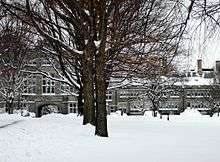
- 1881: Atlanta Baptist Female Seminary (now Spelman College): It was the first historically black female institution of higher education to receive its collegiate charter in 1924, making it the oldest historically black women's college
- 1881: Incarnate Word School: Originally chartered as a women's college, it absorbed an all-female secondary school in 1909, at which time it became the College and Academy of the Incarnate Word. After spinning off the secondary school later in the 20th century, it became coeducational in 1970, and is now known as the University of the Incarnate Word.
- 1881: Tillotson College: Founded as a coeducational, it was a women's college from 1926–1935. It is now the coeducational school, Huston-Tillotson University (historically black college)
- 1883: Seton Hill University: Some academic programs, mainly in the performing arts, became coeducational in the 1980s; became fully coeducational in 2002.
- 1883: Hartshorn Memorial College founded in Richmond, Virginia. In 1932, it merged with Virginia Union University.[14][15]
- 1884: Industrial Institute & College, (now Mississippi University for Women): It was the first public women's college; became coeducational in 1982 as a result of the Supreme Court's Mississippi University for Women v. Hogan case, but maintained its original name
- 1884: Cottey College is founded as "Vernon Seminary," a day and boarding school for girls.
- 1885: Bryn Mawr College (Seven Sisters)
- 1885: The Woman's College of Baltimore: Became Goucher College in 1910 and coeducational during the 1980s
- 1886: H. Sophie Newcomb Memorial College: at Tulane University. It was the first coordinate women's college within a U.S. university. Closed in 2006, but descendants of the founder are suing under the terms of Mrs. Newcomb's will to reopen the college and restore the endowments.
- 1886: Mary Allen Seminary: Founded in Crockett, Houston County, Texas. It became coeducational in 1933.[16]
- 1887: Evelyn College for Women: It was the coordinate women's college of Princeton University in Princeton, New Jersey; it closed in 1897
- 1887: Alverno College
- 1888: Women's College of Western Reserve University (renamed Flora Stone Mather College in 1931) ultimately merged with several other colleges to form the Case Western Reserve University Federation in 1967.
- 1888: Colorado Women's College known as the "Vassar of the West" was founded in Denver, Co; it merged with the University of Denver in 1982.
- 1889: Decatur Female Seminary (now Agnes Scott College): Founded in Decatur, Georgia, it became the Agnes Scott Institute in 1890, and Agnes Scott College in 1906
- 1889: Barnard College (Seven Sisters)
- 1889: Georgia Normal and Industrial College (now Georgia College & State University): The coordinate college for Georgia Tech, it awarded its first degrees in 1917 and became coeducational in 1967.
- 1889: Converse College: Founded in 1889 in Spartanburg, SC.
1890s
- 1890: Mount Saint Agnes College: It closed in 1972
- 1891: Pembroke College: Was the coordinate women's college for Brown University in Providence, Rhode Island; It merged with Brown in 1971
- 1891: Randolph-Macon Woman's College: It become coeducational and changed its name to Randolph College in 2007
- 1891: North Carolina Women's College: It became the coeducational University of North Carolina at Greensboro in 1963
- 1891:Baptist Female University, (now Meredith College): Founded in Raleigh, North Carolina, it became the Baptist University for Women, in 1891, and Meredith College in 1909
- 1893: The Woman's College of Frederick: in Frederick, MD. [now [Hood College]]: Became coeducational in 2002
- 1896: Barber Memorial College: Founded in Anniston, Alabama, it merged with Scotia Women's College (formerly Scotia Seminary) in Concord, North Carolina in 1930 to become Barber-Scotia Junior College (historically black college)
- 1897: Trinity College: Trinity Washington University since 2004
- 1897: Bay Path University
- 1899: Simmons College (Massachusetts)
- 1899: College of Saint Elizabeth
1900s
- 1901: Sweet Briar College
- 1901: Girls Industrial College founded. Known as Texas Woman's University since 1957. Technically co-ed since 1994, but still has a primarily female student body.
- 1901: St. Clara's College: Became coeducational in 1970 and Dominican University (Illinois) in 1997
- 1903: Margaret Morrison Carnegie College: It was the coordinate women's college of Carnegie Mellon University between 1903 and 1973
- 1903: Young Woman's Industrial Club: It became Skidmore College in 1922 and coeducational in 1971
- 1904: The College of New Rochelle
- 1905: Florida State College for Women: Founded as the coeducational West Florida Seminary in 1851. After multiple name changes, it was converted into a women's college in 1905, with "for Women" attached to its then-current name of Florida State College. The school returned to coeducation in 1947 and changed its name yet again to the current Florida State University.
- 1905: St. Catherine University (known as the College of St. Catherine before 2009)
- 1907: College of Saint Teresa: It closed in 1989.
- 1908: All Saints' College: founded in Vicksburg, Mississippi. Associated with the Episcopal Church and admitted only white women.
- 1908: Georgian Court University: Admitted its first male day students in 2012, with men allowed to live on campus and participate in all activities since fall 2013.
- 1908: William Smith College is founded: Eventually becomes a coordinate college known as Hobart and William Smith
- 1908: The State Normal and Industrial School for Women at Harrisonburg: Founded as a junior college, it began awarding bachelor's degrees in 1916, and changed its name three times in its first 30 years. In 1946, when it was known as Madison College, it admitted its first male day students, becoming de facto coeducational, although it would not officially be recognized as a coeducational institution until 1966. In 1976, it adopted its current name of James Madison University.
- 1908: State Normal and Industrial School for Women at Fredericksburg: Developed as a normal and manual arts school and renamed Mary Washington College; it became the coordinate women's college of the University of Virginia in 1944. In 1970, UVA, which had previously admitted women only in its education, nursing, and postgraduate schools, became fully coeducational, as did Mary Washington. The two schools were separated due to changes of mission and geographic distance in 1972. The school's current name, University of Mary Washington, was adopted in 2004.
- 1908: Oklahoma College for Women: Founded as Oklahoma Industrial Institute and College for Girls, but name was changed to Oklahoma College for Women in 1912. Became coeducational in 1965 and simultaneously renamed Oklahoma College of Liberal Arts. Currently named University of Science and Arts of Oklahoma.[17]
- 1909: Lesley College: It became coeducational in 2005
1910s
- 1911: Pine Manor College: became coeducational in 2014
- 1911: Connecticut College: became coeducational in 1969
- 1912: Saint Joseph's College of Maine: became coeducational in 1970
- 1913: College of Saint Benedict: Has been partnered with the all-male Saint John's University, located about 5 miles (8 km) away, since 1955, and the two schools have operated a common academic program with fully coeducational classes since 1961. CSB and SJU remain legally and administratively separate, with separate residential facilities and athletic programs.
- 1914: Westhampton College: Founded as the coordinate college for Richmond College (1830) and a component of its growth into the University of Richmond (1920). Today, the academic operations of the two colleges are merged, but Westhampton College remains as the co-curricular program for undergraduate women and curricular women's studies.
- 1914: Johnson & Wales School of Business: Started as a business school for women with one typewriter and one student. The mission “to teach a thing not for its own sake but for what lies beyond” is still in line with JWU’s current mission. The school, through many name changes is now Johnson & Wales University.
- 1916: Russell Sage College
- 1916: St. Joseph's College for Women: became coeducational in 1970 and renamed St. Joseph's College, New York
- 1918: New Jersey College for Women: Founded as the coordinate college for Rutgers University and became Douglass College in 1955. In 2007, it was merged with the other undergraduate liberal arts colleges at the main Rutgers campus, at that time becoming a non-degree granting unit of Rutgers and being renamed Douglass Residential College.
- 1919: Emmanuel College, Boston: became coeducational in 2001
1920s
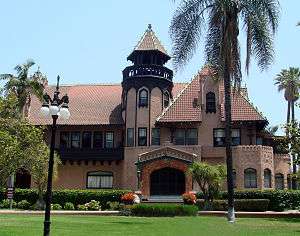
- 1920: College of Mount St. Joseph: Technically founded in 1920, when it received formal state approval to operate as a college, but predecessor institutions had offered two years of college education for females for several decades. Became coeducational in 1986, and adopted its current name of Mount St. Joseph University in 2014.
- 1920: Villa Maria College: Became Immaculata College in 1929 and Immaculata University in 2002. It became coeducational in 2005.
- 1921: Rosemont College
- 1921: Villa Madonna College: Although founded as a women's college, it was affiliated with the all-male St. Thomas More College. In 1945, Villa Madonna became coeducational, absorbing St. Thomas More College. The school adopted its current name of Thomas More College in 1968.
- 1922: Notre Dame College (Ohio): Became coeducational in the spring term of 2001.
- 1923: College of Saint Mary
- 1923: Marymount Junior College: Became Marymount College of Los Angeles in 1948 when it began offering bachelor's degrees. Merged with Loyola University of Los Angeles, originally all-male at the undergraduate level but later partially coed, in 1973 to create Loyola Marymount University.
- 1923: Mount St. Scholastica College: Merged with the all-male St. Benedict's College in 1971 to form the co-educational Benedictine College
- 1924: Chestnut Hill College: Began a coeducational graduate program in 1980, and became fully coeducational in 2003.
- 1925: Albertus Magnus College: It became coeducational in 1985
- 1925: Mount Saint Joseph College for Women: Originally located in the rural Daviess County, Kentucky community of Maple Mount, the school soon opened a coeducational extension branch in nearby Owensboro. The extension branch eventually grew into its own campus, and the school became coeducational when the two campuses were merged at the Owensboro location in 1950. Became Brescia College in 1951 and Brescia University in 1998.
- 1925: Mount St. Mary's College
- 1926: Mercyhurst College: It became coeducational in 1969, and adopted its current name of Mercyhurst University in 2012.
- 1926: Sarah Lawrence College: It became coeducational in 1968
- 1926: Scripps College
- 1927: Regis College: It become coeducational in 2007
- 1928: Elms College: It became coeducational in 1998.
1930s–1980s
- 1930: Mundelein College: Became coeducational in 1968, but remained primarily women-serving; absorbed into Loyola University Chicago in 1991.
- 1932: Bennington College: It became coeducational in 1969
- 1932: Saint Joseph College (Connecticut)
- 1936: Marymount Manhattan College: It is currently coeducational
- 1938: Ursuline College (Kentucky): Merged into the previously all-male Bellarmine College in 1968; the merged school is now Bellarmine University.
- 1941: Annhurst College: It closed in 1980
- 1941: Mercy College of Detroit: Opened as a women's college, later became coeducational, and merged with the University of Detroit in 1990, creating the University of Detroit Mercy.
- 1946: Mount Sacred Heart College: It closed in 1997
- 1947: Garland Junior College: It was absorbed into Simmons College in 1976.
- 1954: Stern College for Women
- 1963: Pitzer College: It became coeducational in 1970
- 1968: Kirkland College: It merged with Hamilton College in 1979
- 1982: Women's College of the University of Denver reclaimed its historical name Colorado Women's College in 2013
See also
Further reading
- Creighton, Joanne V. A Tradition of Their Own: Or, If a Woman Can Now Be President of Harvard, Why Do We Still Need Women’s Colleges?.
- Guy-Sheftall, Beverly. "Black Women and Higher Education: Spelman and Bennett Colleges Revisited." The Journal of Negro Education, Vol. 51, No. 3, The Impact of Black Women in Education: An Historical Overview (Summer, 1982), pp. 278–287.
- Kiss, Elizabeth. "Reaffirming Our Commitment to Women's Education". Agnes Scott College. Retrieved October 20, 2006.
- Harwarth, Irene B. "A Closer Look at Women's Colleges." National Institute on Postsecondary Education, Libraries, and Lifelong Learning, Office of Educational Research and Improvement, U.S. Department of Education, 1999.
- ---, Mindi Maline and Elizabeth DeBra. "Women's Colleges in the United States: History, Issues, and Challenges: Executive Summary." U.S. Department of Education National Institute on Postsecondary Education, Libraries, and Lifelong Learning.
- Indiana University Center for Postsecondary Research (IUCPR). "New study finds women’s colleges are better equipped to help their students."
- Horowitz, Helen Lefkowitz. Alma Mater: Design and Experience in the Women's Colleges from Their Nineteenth-Century Beginnings to the 1930s, Amherst: University of Massachusetts Press, 1993 (2nd edition).
- Muhlenfeld, Elisabeth and Nancy Gray. "Women's colleges must be an option." The Roanoke Times, September 14, 2006.
- Rosenberg, Rosalind. "The Limits of Access: The History Of Coeducation in America." In Women and Higher Education: Essays from the Mount Holyoke College Sesquicentennial Symposia. Ed. John Mack Faragher and Florence Howe. New York: Norton, 1988.
- Scrimshaw, Susan (October 4, 2006). "Yes to women's colleges". The Boston Globe. Archived from the original on October 25, 2006. Retrieved October 14, 2006.
- Simpson, April (November 5, 2006). "'Sisters' don't want a future in coeducation: Women's colleges see an obligation". The Boston Globe. Retrieved November 6, 2006.
- Whitson, Caroline (October 17, 2006). "The case for women's colleges". Columbia College. Archived from the original on September 26, 2007. Retrieved October 20, 2006.
Notes
- ↑ The Rise of Women's Colleges, Coeducation Archived May 16, 2008, at the Wayback Machine.
- ↑ "Our History | Salem College". www.salem.edu. Retrieved 2016-12-01.
- ↑ "A timeline of North Carolina colleges (1766–1861) - North Carolina Digital History". www.learnnc.org. Retrieved 2016-12-01.
- ↑ "Moravian College history". Archived from the original on October 9, 2014. Retrieved October 6, 2014.
- ↑ "Mrs. Susanna Rowson's School & Myra Montgomery in Boston, 1805-1808". www.silkdamask.org. Retrieved 2016-12-01.
- ↑ "The Litchfield Historical Society". www.litchfieldhistoricalsociety.org. Retrieved 2016-12-01.
- ↑ "Bradford College Alumni Association History". www.bradfordalumni.org. Retrieved 2016-12-01.
- ↑ "The Ipswich Female Seminary". Stories From Ipswich and the North Shore. 2014-04-03. Retrieved 2016-12-01.
- ↑ http://www.goodreads.com/book/show/18474187-good-catholics
- ↑ Mary Medley, History of Anson County, N.C., 1760-1976 (1976)
- ↑ "Columbia College History". Retrieved October 6, 2014.
- ↑ Virginia State Council of Higher Education. The Virginia Plan for Higher Education, January 1974, p. 140.
- ↑ "Ursuline College | The Leading Women's College in Ohio | Ursuline at a Glance". www.ursuline.edu. Retrieved 2016-12-01.
- ↑ "A Guide to the Hartshorn Memorial College Reunion Collection 1976–1980". Retrieved October 6, 2014.
- ↑ Photos Archived January 3, 2009, at the Wayback Machine.
- ↑ "Mary Allen Seminary". Retrieved October 6, 2014.
- ↑ Savage, Cynthia. "University of Science and Arts of Oklahoma," Encyclopedia of Oklahoma History and Culture, Oklahoma Historical Society. Accessed September 2, 2015.
